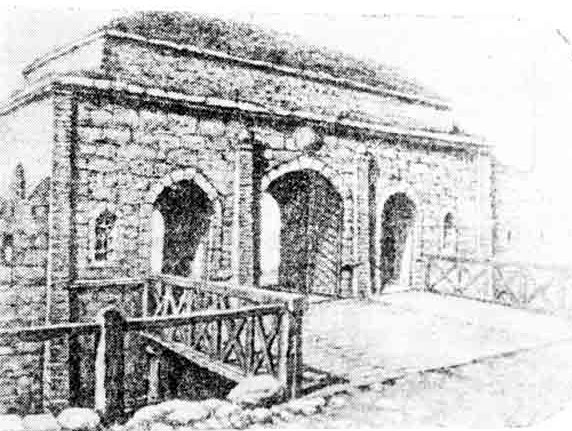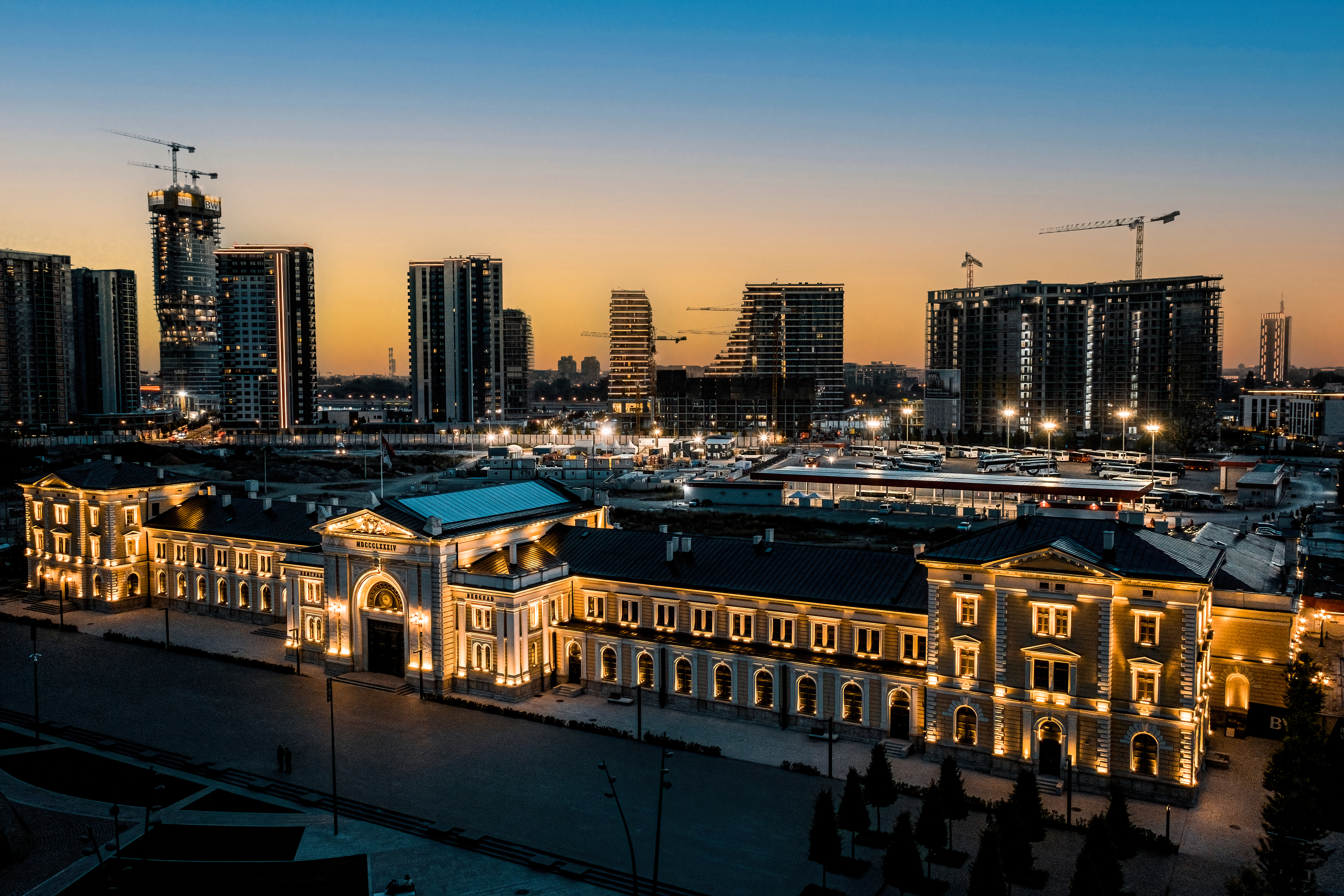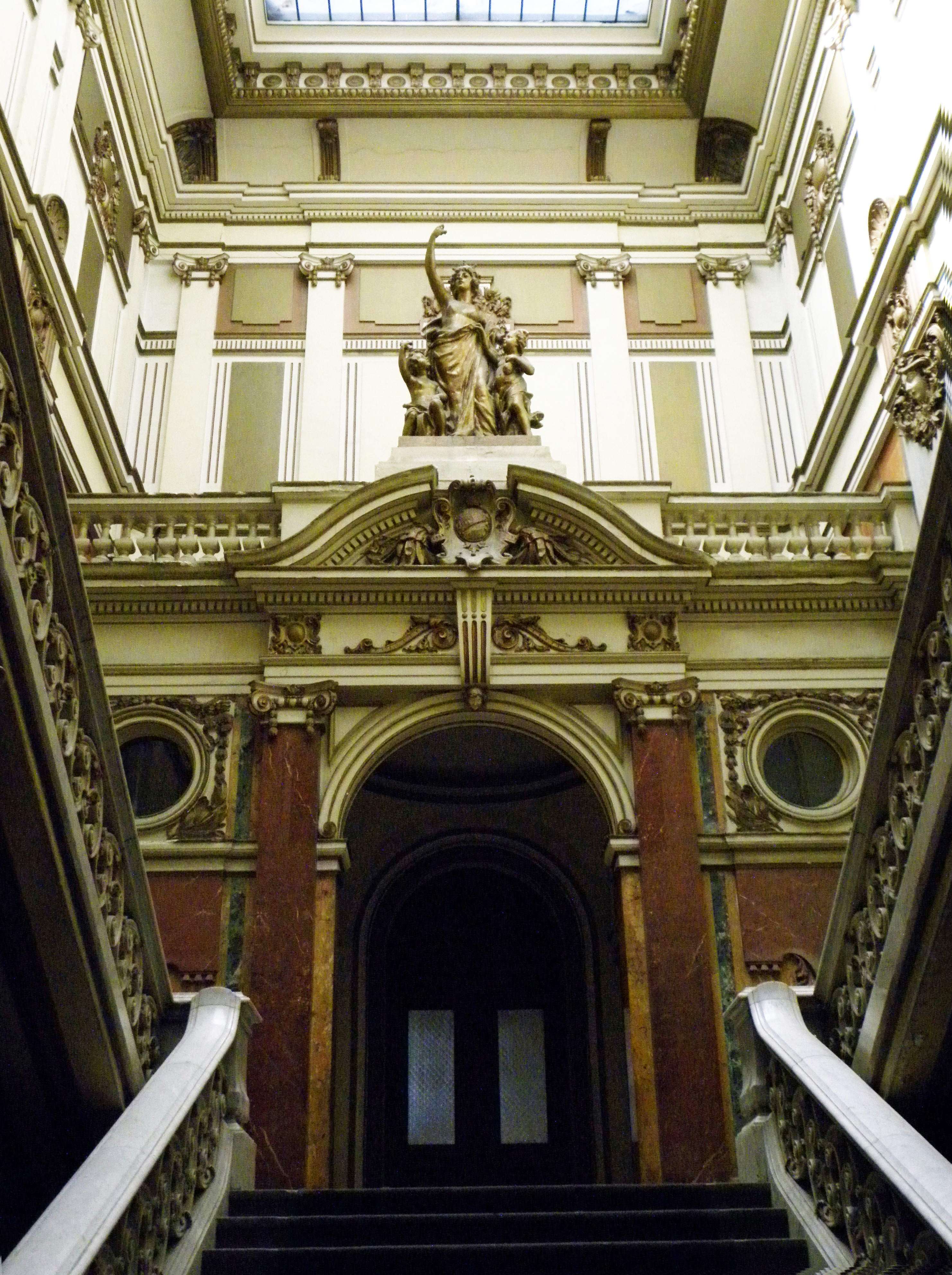|
Old Post Office (Belgrade, Serbia)
The Old Post Office (), is a former building in Belgrade, modern-day Serbia. Located next to Belgrade Main railway station, it was considered to be one of the most beautiful buildings and symbols of the city. Built in Serbo-Byzantine Revival style upon plans by Momir Korunović, Post Office was mostly destroyed by Allied bombing of Yugoslavia in World War II and later reconstructed in 1947 in a functionalist style. Location The building is located just south of the Belgrade Main railway station, in the southern corner of the Sava Square, at 2 Savska Street. It is situated in the neighborhood of Bara Venecija, or the extreme south extension of Savamala. Being at the beginning of the Savska Street, it is across the Saint Sava Hospital, while the Monument to Stefan Nemanja and pedestrian section of the Ssva Square are to the northeast. History Origin Built as the Post Office No. 2 in the 1920s, it was constructed by architect Momir Korunović, nicknamed Serbian Gaud ... [...More Info...] [...Related Items...] OR: [Wikipedia] [Google] [Baidu] |
Serbo-Byzantine Revival
The Modern Serbo-Byzantine architectural style, Neo-Byzantine architectural style or Serbian national architectural style is the style in Serbian architecture which lasted from the second half of the 19th century to the first half of the 20th century. This style originated in the tradition of medieval Serbian-Byzantine school and was part of international Neo-Byzantine style. History and characteristics The beginning of the modern Serbian-Byzantine style lies in the romantic spirit, which was prevalent in Europe in the first half of the 19th century, and in the Serbian lands appeared by the mid-century and was alive to its last decades. The beginning of this style can be seen as "resistance" to newcomers' influences of the "western-style" (Classicism, Neo-Baroque) in the Principality of Serbia. The style is characterized by forms and decorations from the Serbian-Byzantine architectural heritage. This architectural approach is not strictly tied to the church architecture; in ... [...More Info...] [...Related Items...] OR: [Wikipedia] [Google] [Baidu] |
Politika
( sr-Cyrl, Политика, lit=Politics) is a Serbian daily newspaper, published in Belgrade. Founded in 1904 by Vladislav F. Ribnikar, it is the oldest daily newspaper still in circulation in the Balkans. Publishing and ownership is published by Politika novine i magazini (PNM), a joint venture between Politika a.d. and East Media Group. The current director of PNM is Mira Glišić Simić. PNM also publishes: *''Sportski žurnal'' *''Politikin Zabavnik'' *''Svet kompjutera'' *''Ilustrovana Politika'' *''Bazar'' History Since its launch in January 1904, was published daily, except for several periods: *Due to World War I, there were no issues from 14 November 1914 to 21 December 1914, and again from 23 September 1915 to 1 December 1919. *Due to World War II, there were no issues from 6 April 1941 to 28 October 1944. *In protest against the government's intentions to turn into a state-owned enterprise, a single issue was not published in the summer of 1992. The launc ... [...More Info...] [...Related Items...] OR: [Wikipedia] [Google] [Baidu] |
Buildings And Structures In Belgrade
A building or edifice is an enclosed structure with a roof, walls and windows, usually standing permanently in one place, such as a house or factory. Buildings come in a variety of sizes, shapes, and functions, and have been adapted throughout history for numerous factors, from building materials available, to weather conditions, land prices, ground conditions, specific uses, prestige, and aesthetic reasons. To better understand the concept, see ''Nonbuilding structure'' for contrast. Buildings serve several societal needs – occupancy, primarily as shelter from weather, security, living space, privacy, to store belongings, and to comfortably live and work. A building as a shelter represents a physical separation of the human habitat (a place of comfort and safety) from the ''outside'' (a place that may be harsh and harmful at times). buildings have been objects or canvasses of much artistic expression. In recent years, interest in sustainable planning and building practi ... [...More Info...] [...Related Items...] OR: [Wikipedia] [Google] [Baidu] |
Republic Square, Belgrade
The Republic Square or the Square of the Republic ( sr-cyr, Трг републике, Trg republike) is one of the central town squares and an urban neighborhood of Belgrade, located in the Stari Grad municipality. It is the site of some of Belgrade's most recognizable public buildings, including the National Museum, the National Theatre and the statue of Prince Michael. Location The square is located less than 100 meters away from Terazije, designated center of Belgrade, to which it is connected by the streets of ''Kolarčeva'' (traffic) and ''Knez Mihailova'' (pedestrian zone). Many people erroneously consider Square of the Republic to be the center of the city. Through ''Vasina'' street it is connected to the fortress and park of Kalemegdan to the west and through Sremska street it is connected to the neighborhood of Zeleni Venac and further to Novi Beograd. It also borders the neighborhoods of Stari Grad and Dorćol, to the north. Today, it makes one of the local comm ... [...More Info...] [...Related Items...] OR: [Wikipedia] [Google] [Baidu] |
Belgrade Waterfront
Belgrade Waterfront (), is an urban renewal development project headed by the Government of Serbia aimed at changing Belgrade's cityscape and economy by revitalizing the Sava amphitheater, between the Belgrade Fair and Branko's bridge, including the Savamala neihgbourhood. It was started in 2014 with the reconstruction of the Belgrade Cooperative building, which was finished in June of the same year. It is the second largest mixed use complex under construction in Europe, just after Minsk Mir, worth $3.5 billion. Belgrade Waterfront complex will include 10,000 residential units, bilingual elementary school and kindergartens, luxury hotels including St. Regis, the largest shopping mall in southeast Europe Galerija, and public buildings. In total, about 1.8 million square meters will be built. The project was initiated in 2014 between the Government of Serbia and Eagle Hills Properties, a leading Abu Dhabi–based private investment and development company focused on creating ... [...More Info...] [...Related Items...] OR: [Wikipedia] [Google] [Baidu] |
BIGZ Building
The BIGZ building () is a building located in Belgrade, the capital of Serbia. Designed by Dragiša Brašovan, it is one of the most representative architectural landmarks of Serbian modern architecture. A monumental building, with its position, volume and aesthetics, it dominates the entrance in the southern section of Belgrade. It remained the tallest building in Belgrade for 23 years, until being surpassed by Ušće Tower 1 in 1964. It has been protected since 1992. In recent times it represents a significant cultural, artistic and social spot. Location The BIGZ building is located at 17 ''Bulevar vojvode Mišića'', in the Mostar section of the Senjak neighborhood, west of the Mostar looped interchange on the Highway Belgrade–Niš. Just east of the building is the Radisson Collection Hotel, Old Mill Belgrade, declared a cultural monument in 1987. Across the ''Bulevar vojvode Mišića'', the facilities of the Belgrade Fair are located. With its height and monumen ... [...More Info...] [...Related Items...] OR: [Wikipedia] [Google] [Baidu] |
National Museum Of Serbia
The National Museum of Serbia () is the largest and oldest museum in Belgrade, Serbia. It is located in the central zone of Belgrade on a square plot between the Republic Square (Belgrade), Republic Square, formerly Theatre Square, and three streets: Čika Ljubina, Vasa Čarapić, Vasina and Lazar Paču, Laze Pačua. Its main facade is on the Republic Square and the official address is 1a Republic Square. The museum was established on 10 May 1844. It moved into the present building in 1950, with the grand opening of the venue on 23 May 1952. Since its founding, the museum's collection has grown to over 400,000 objects, including many foreign masterpieces. The National Museum of Serbia building was declared a Monuments of Culture of Great Importance (Serbia), Monument of Culture of Great Importance in 1979. History Before the erection of the building of the National Museum on this place was a famous tavern called "Dardanelles", meeting point of the cultural and artistic elit ... [...More Info...] [...Related Items...] OR: [Wikipedia] [Google] [Baidu] |
Belgrade Cooperative
Belgrade Cooperative () was a Serbian cooperative bank founded in 1882 to promote savings and support small enterprises, craftspeople and the poor of Belgrade. Member-shareholders have been paying membership in amount of one Serbian Dinar per week. That was the way for cooperative to become a public savings bank. Luka Ćelović was the first president of cooperative, also a first Serbian insurance group. The cooperative was notable for the building it built on Karađorđeva Street in Belgrade in 1907 and used as its headquarters until the cooperative was closed in 1944. The Palace of the Belgrade Cooperative was designated as a cultural monument since 1966 and was declared a cultural asset of great importance by the Serbian government in 1979. History The construction of Belgrade Cooperative coincided with the change of political regime in Serbia. After the assassination of the king Aleksandar Obrenović, the Karadjordjevic dynasty came to power, which led to a change in th ... [...More Info...] [...Related Items...] OR: [Wikipedia] [Google] [Baidu] |
Pošta Srbije
Pošta Srbije ( sr-Cyrl, Пошта Србије, lit=Post of Serbia) is the national postal service of Serbia, with the headquarters in Belgrade. Public postal service was first introduced in Serbia in 1840. The first stamp was printed in 1866. In 1874 it founded the Universal Postal Union together with 21 other countries. History * 1840 – First public postal service introduced in Serbia * 1866 – The first Postal Law was passed and the first postal stamp was issued. * 1874 – Serbia among 21 founding members of Universal Postal Union in Bern, Switzerland. * 1945 – Serbian Post becomes state-owned enterprise. * 1989 – Serbian post restructured as Public Enterprise of PTT Saobraćaja "Srbija". * 1997 – PTT Saobraćaja "Srbija" transformed into holding company (Telekom Srbija founded). * 2001 – Serbia re-entered the Universal Postal Union * 2003 – Rail transport of postal items discontinued. * 2005 – New Postal Services Law enacted. * 2010 – Law on Postal Service ... [...More Info...] [...Related Items...] OR: [Wikipedia] [Google] [Baidu] |
NKVD
The People's Commissariat for Internal Affairs (, ), abbreviated as NKVD (; ), was the interior ministry and secret police of the Soviet Union from 1934 to 1946. The agency was formed to succeed the Joint State Political Directorate (OGPU) secret police organization, and thus had a monopoly on intelligence and state security functions. The NKVD is known for carrying out political repression and the Great Purge under Joseph Stalin, as well as counterintelligence and other operations on the Eastern Front of World War II. The head of the NKVD was Genrikh Yagoda from 1934 to 1936, Nikolai Yezhov from 1936 to 1938, Lavrentiy Beria from 1938 to 1946, and Sergei Kruglov in 1946. First established in 1917 as the NKVD of the Russian SFSR, the ministry was tasked with regular police work and overseeing the country's prisons and labor camps. It was disbanded in 1930, and its functions dispersed among other agencies before being reinstated as a commissariat of the Soviet Union ... [...More Info...] [...Related Items...] OR: [Wikipedia] [Google] [Baidu] |
OGPU
The Joint State Political Directorate ( rus, Объединённое государственное политическое управление, p=ɐbjɪdʲɪˈnʲɵn(ː)əjə ɡəsʊˈdarstvʲɪn(ː)əjə pəlʲɪˈtʲitɕɪskəjə ʊprɐˈvlʲenʲɪje), abbreviated as OGPU (), was the secret police of the Soviet Union from November 1923 to July 1934, succeeding the State Political Directorate (GPU). Responsible to the Council of People's Commissars, the OGPU was headed by Felix Dzerzhinsky until 1926, then by Vyacheslav Menzhinsky until replaced by the Main Directorate of State Security (GUGB) within the People's Commissariat for Internal Affairs (NKVD). The OGPU played an important role in the Soviet Union's forced collectivization of agriculture under the leadership of Joseph Stalin, crushing resistance and deporting millions of peasants to the growing network of Gulag forced labor camps. The OGPU operated both inside and outside the country, persecuting political cri ... [...More Info...] [...Related Items...] OR: [Wikipedia] [Google] [Baidu] |






